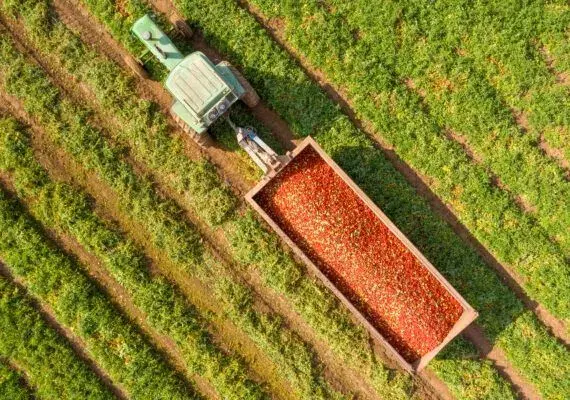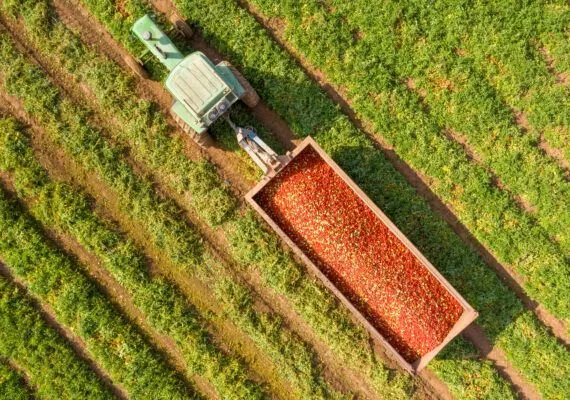
Preparing tomatoes for cultivation in the ground
Properly prepared tomato seedlings have a significant impact on the growth of plants and their resistance, which directly translates into plant yield. You can either prepare them yourself or purchase ready-made tomato seedlings and plant them in the ground.
The soil onto which tomatoes will be sown, then pricked out and transplanted into, should meet appropriate sanitary conditions. It must be free from weed seeds, nematodes, as well as pathogens of bacterial and fungal origin. These could threaten emerging seedlings and expose them to diseases, which in turn would harm the health of plants and negatively affect future yields.
When to sow tomatoes?
Before sowing tomato seeds, it is necessary to prepare well-drained and permeable soil. Seeds of selected varieties should be sown either into seed trays with several seeds each or into individual small pots. A small depression should be made in the sowing location and the seed placed into it, then covered gently with soil and moistened. Until germination, trays can be covered with plastic wrap to provide seeds with suitable conditions for growth. The plastic should be removed once a day to aerate the germinating seeds. Seedlings need to be kept at a temperature of around 20 degrees Celsius during germination. The first shoots should appear within 7 days. As soon as the first seedlings are noticed, the plastic should be removed. Seedlings should be placed in a heated greenhouse during germination.
Tomato sowing usually takes place around late February and March. It’s advisable to follow the guidelines of a gardening calendar. The sowing dates for tomatoes under cover are slightly different than for field cultivation. If you plan to plant them in the field, it’s best to sow seeds around March 15th. Then, the seedlings will be ready for planting in the ground around May 15th. During this time, frost in May is most common.

How to care for seedlings?
When seedlings are about 3 weeks old and have already developed two pairs of true leaves, you can proceed with pricking them out. This procedure involves transplanting small plants into larger individual pots and burying them up to the cotyledons. This is a very important care procedure that enhances the development of the tomato seedlings’ root system. It’s also crucial not to forget about watering the plants. This should be done twice a week.
Planting tomatoes on the ground
For tomatoes to grow well, they require suitable soil with the right pH and rich in nutrients. It’s also necessary to protect them from pests and diseases and prevent weed spread.
What soil is best for growing tomatoes?
The best soils for growing tomatoes are loams, alluvial soils, as well as permeable black soils, and mineralized peat soils. However, it’s worth knowing that tomatoes are planted in black soils and peat fruit later, which increases the risk of fruit damage during frosts. Plants grown in lighter soils yield earlier and have greater disease resistance. The optimal pH range for tomatoes is between 5.2 and 6.0. The soil must be rich in calcium, as calcium deficiencies contribute to blossom end rot in fruits. Therefore, the effect of liming on plant growth is significant.
For industrial tomato cultivation, areas where frost does not occur after May 15–20 and does not appear before early October are most suitable.
Crop rotation in tomato cultivation
Tomatoes should be grown on the same plot every 3–4 years. This is necessary due to the possibility of diseases or fungal pathogens being transferred from year to year, which can overwinter in the soil and infect the entire tomato plantation. It’s important to avoid planting tomatoes near potato fields as ground cherries could be affected by potato blight. Tomatoes should also not be planted in fields after potatoes, as this increases the risk of beetle damage to the plants after winter. Therefore, crop rotation technique in tomato cultivation is extremely important.
Tomatoes can be planted after cereals, legumes, clover, celery, beets, onions, cucumbers, and brassica vegetables.
High-growing tomato varieties have deep roots, so it’s important to plant them after plants with a shallower root system. Dwarf tomato varieties have shallower roots, so they can be planted after species with deeper root systems, such as beans, beets, or brassica vegetables.
What nutrients do tomatoes need?
To grow healthily, tomatoes need the following nutrients in the soil:
- 90–120 mg/dm3 of nitrogen
- 60–80 mg/dm3 of phosphorus
- 200–250 mg/dm3 of potassium
- 60–80 mg/dm3 of magnesium
- 250–400 mg/dm3 of calcium
How to lime tomato cultivation?
For proper growth, tomatoes require a soil pH between 5.2 and 6.0. However, they do not like fresh liming of the soil. On light soils, this procedure is carried out every 2–3 years, and on heavy soils, every 3–4 years.
The dosage of lime fertilizers in the field prepared for cultivation should be as follows:
- 10 dt/ha for light soils
- 15 dt/ha for moderately compacted soils
- 20 dt/ha for heavy soils
These doses should not be exceeded as higher concentrations of calcium can worsen the absorption of phosphorus and micronutrients. It’s advisable to use dolomitic lime for liming, as magnesium also plays an important role in tomato cultivation.
For liming the field for tomato cultivation, you can use SUPERMAG granulated lime from Polcalc company. The dosage should be from 400 to 500 kg per hectare. The best time to apply granulated lime is from harvest to late autumn.
What are the most common diseases affecting tomatoes?
The diseases that most commonly affect tomato crops are:
- late blight – a fungal disease that can cause the loss of entire plants;
- stem base rot and brown rot of tomato fruits – fungal diseases that can also lead to the loss of entire plants;
- gray mold – a fungal disease mainly affecting tomatoes grown under cover;
- bacterial canker of tomato – a bacterial disease causing leaf necrosis, followed by fruit rot;
- blossom end rot of tomato – a physiological disease causing black spots on fruits resulting from calcium deficiency.
Which tomato varieties are best for planting in the ground?
Many tomato varieties are suitable for planting in the ground. They differ in disease resistance, shape, taste, and popularity among consumers. Most often, you can find varieties with round or elongated fruits:
- with round fruits:
’Anula’ – an early variety, 90 g fruits, resistant to cracking
’Delta’ – a medium-early variety, indeterminate, 100 g fruit, with no tendency to crack
’Etna’ F1 – an early variety, very productive, 90 g fruits - with elongated fruits:
’Bazalt’ – a medium-early variety, productive, 70 g fruits
’Kmicic’ – a medium-early variety, productive, 50 g fruits
’Lima’ – medium-early, very productive, one of the oldest varieties in Poland, elongated fruits up to 70 g






